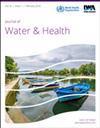揭开病毒逃逸的神秘面纱:预凝和膜过滤中微絮结合病毒的定量分析
IF 2.5
4区 环境科学与生态学
Q3 ENVIRONMENTAL SCIENCES
引用次数: 0
摘要
在物理去除工艺之前进行预凝,可望达到较高的病毒去除率。然而,病毒可能会形成小絮体,随后在物理去除过程中逃逸到污水中。本研究评估了如何使用传统的病毒定量方法(斑块检测法和定量聚合酶链反应 (qPCR))对微絮凝体中的病毒进行定量,以揭示低估病毒浓度的风险。本研究采用微絮体在磷酸盐缓冲溶液中的溶解现象作为絮体溶解试验。假定在絮凝体溶解前后对水处理进行量化,在实验条件下形成的微絮凝体中的病毒。研究结果表明,根据斑块检测法,病毒浓度增加了 1.0-3.9 对数斑块形成单位/毫升,根据 qPCR 法,病毒浓度增加了 1.7-4.0 对数拷贝/毫升。这种增加发生在腐殖酸测试水中制备的微絮体溶解之后。在处理过的废水中,根据斑块检测法,所有样本中的病毒浓度都有所增加,根据 qPCR 法,8 个样本中有 7 个样本中的病毒浓度有所增加。我们的研究结果表明,有必要仔细考虑预凝和物理去除系统后的病毒定量问题。本文章由计算机程序翻译,如有差异,请以英文原文为准。
Unveiling the viral escape: quantification of microfloc-bound viruses in precoagulation and membrane filtration
The implementation of precoagulation before the physical removal process is expected to achieve a high virus removal rate. However, viruses may form small flocs and subsequently escape into the effluent during physical removal processes. This study evaluated how viruses in the microflocs could be quantified using conventional virus quantification methods (plaque assay and quantitative polymerase chain reaction (qPCR)) to reveal the risk of underestimating virus concentration. In this study, the microfloc dissolution phenomenon in phosphate buffer solution was employed as a floc dissolution test. Viruses in microflocs formed under the experimental conditions, assuming that water treatments were quantified before and after floc dissolution. The findings revealed that virus concentrations increased by 1.0–3.9 log plaque-forming units/mL according to the plaque assay and by 1.7–4.0 log copies/mL according to the qPCR. This increase occurred after the dissolution of microflocs that were prepared in the humic acid test water. In the case of treated wastewater, virus concentrations increased in all samples according to the plaque assay and in seven of eight samples according to the qPCR. Our results indicate the necessity of careful consideration of virus quantification after precoagulation and physical removal systems.
求助全文
通过发布文献求助,成功后即可免费获取论文全文。
去求助
来源期刊

Journal of water and health
环境科学-环境科学
CiteScore
3.60
自引率
8.70%
发文量
110
审稿时长
18-36 weeks
期刊介绍:
Journal of Water and Health is a peer-reviewed journal devoted to the dissemination of information on the health implications and control of waterborne microorganisms and chemical substances in the broadest sense for developing and developed countries worldwide. This is to include microbial toxins, chemical quality and the aesthetic qualities of water.
 求助内容:
求助内容: 应助结果提醒方式:
应助结果提醒方式:


